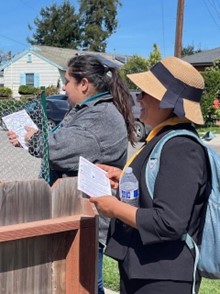Reaching Communities through Trusted Messengers
Region 6
The unprecedented challenges California has faced in recent years has demonstrated the State must remain ready to coordinate and communicate effectively with the diverse range of communities it serves.
A deep commitment to equity and inclusion for all Californians is what unites community-based organizations and the State.
While the State provides data, messaging, and operational support, community-based organizations adapt messaging with sensitivity to the lived experiences of those served. Providing culturally and linguistically customized outreach requires an understanding of the structural inequalities of a neighborhood and region.
Community-based organization outreach workers offer their lived experiences and language competency and provide a grounded understanding of the realities of the individuals and families they serve.
Empathy and trust are key to their work and require showing understanding, sharing the facts and supporting the individual to make an informed decision.
Pajaro Valley Prevention and Student Assistance
Pajaro Valley Prevention and Student Assistance hires bilingual community health workers with similar stories, experiences and cultural backgrounds as the community members they serve. Their team overcomes challenges through adaptive outreach strategies, while building rapport and trust, as they strive to provide community members with equitable access to resources.
Image Description (pictured right): Promotoras chatting about protection from extreme heat with a local resident

Community-based organizations use a trusted messenger model by recruiting outreach workers (also known as promotoras de salud, community health workers or navigators) to share information so that community members can make informed decisions. This effective model was recognized during California’s Census 2020 efforts and replicated in other outreach efforts.
These tested outreach approaches were gleaned from engagements with outreach workers in the Salinas Valley, Merced, Santa Cruz, Madera, and Northern San Diego.
How to Reach Community Members

- Show up consistently to build trust
- Start a conversation by acknowledging people’s situations, priorities, and fears
- Simplify information so it is easy to understand while avoiding medical or legal terms
- Use methods they are accustomed to, such as an in-person, eye-to-eye conversations rather than a flyer they may not read
“Relationships matter, especially when you are working with fragmented communities who have endured multiple life-changing events. We create opportunities for community members to engage with one another, learn from each other and test their knowledge. They then commit to sharing the message with one person, which also helps them see themselves as educators.”
Adriana Mata | Pajaro Valley Prevention and Student Assistance
